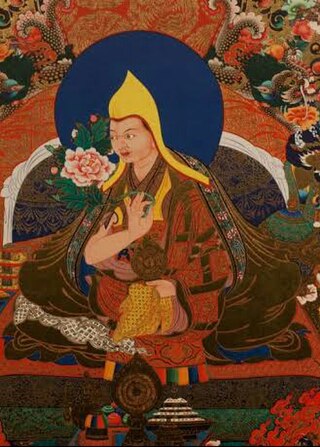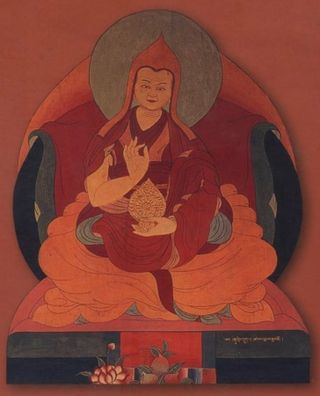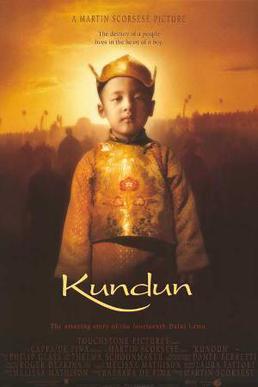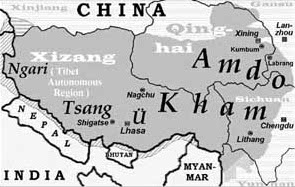Related Research Articles

The 1st Dalai Lama, Gedun Drupa was a student of Je Tsongkhapa, and became his first Khenpo (Abbott) at Ganden Monastery. He also founded Tashi Lhunpo Monastery in Shigaste. He was posthumously awarded the spiritual title of Dalai Lama.

Amdo is one of the three traditional Tibetan regions, the others being Ü-Tsang in the west and Dotoe also known as Kham in the east. The formal name of Amdo is Domey in literatures. Historically, Amdo and Kham together were also called Do Kham on maps and manuscripts. Amdo encompasses a large area from the Machu to the Drichu (Yangtze). Amdo is mostly coterminous with China's present-day Qinghai province, but also includes small portions of Sichuan and Gansu provinces.

The 6th Dalai Lama, Tsangyang Gyatso, was recognized as the 6th Dalai Lama after a delay of many years, permitting the Potala Palace to be completed. He was an unconventional Dalai Lama that preferred a Nyingma school yogi's life to that of an ordained monk. He was later kidnapped and deposed by the Koshut Lha-bzang Khan.

The music of Tibet reflects the cultural heritage of the trans-Himalayan region centered in Tibet, but also known wherever ethnic Tibetan groups are found in Nepal, Bhutan, India and further abroad. The religious music of Tibet reflects the profound influence of Tibetan Buddhism on the culture.

Kundun is a 1997 American epic biographical film written by Melissa Mathison and directed by Martin Scorsese. It is based on the life and writings of Tenzin Gyatso, the 14th Dalai Lama, the exiled political and spiritual leader of Tibet. Tenzin Thuthob Tsarong, a grandnephew of the Dalai Lama, stars as the adult Dalai Lama, while Tencho Gyalpo, a niece of the Dalai Lama, appears as the Dalai Lama's mother.

The 5th Dalai Lama, Ngawang Lobsang Gyatso was recognized as the 5th Dalai Lama, and he became the first Dalai Lama to hold both Tibet's political and spiritual leadership roles. He is often referred to simply as the Great Fifth, being the key religious and temporal leader of Tibetan Buddhism and Tibet. He is credited with unifying all of Tibet under the Ganden Phodrang, after Gushri Khan's successful military interventions. As an independent head of state, he established priest and patron relations with both Mongolia and the Qing dynasty simultaneously, and had positive relations with other neighboring countries. He began the custom of meeting early European explorers. The 5th Dalai Lama built the Potala Palace, and also wrote 24 volumes' worth of scholarly and religious works on a wide range of subjects.

Chushi Gangdruk was a Tibetan guerrilla group. Formally organized on 16 June 1958, the Chushi Gangdruk fought the forces of the People's Republic of China (PRC) from 1956 until 1974 when the Central Intelligence Agency (CIA) withdrew its support for the guerrilla group.

Kyabje Dudjom Rinpoche Jigdral Yeshe Dorje was known simply as Dudjom Rinpoche. He is considered by many Tibetan Buddhists to be from an important Tulku lineage of Terton Dudul Dorje (1615–1672), and was recognized as the incarnation of Terton Dudjom Lingpa (1835–1904), a renowned treasure revealer. He was a direct incarnation of both Padmasambhava and Dudjom Lingpa. He was a Nyingma householder, a yogi, and a Vajrayana and Dzogchen master. According to his secretary Khenpo Tsewang Dongyal and many others, he was revered as "His Holiness" (Kyabje) and as a "Master of Masters".

Jetsun Pema is the sister of the 14th Dalai Lama. For 42 years she was the President of the Tibetan Children's Villages (TCV) school system for Tibetan refugee students.

Tertön Sogyal Lerab Lingpa was a Tibetan Buddhist tertön and a teacher of the Thirteenth Dalai Lama.
This is a list of topics related to Tibet.

Kumbum Monastery, also called Ta'er Temple, is a Tibetan gompa in Lusar, Huangzhong County, Xining, Qinghai, China. It was founded in 1583 in a narrow valley close to the village of Lusar in the historical Tibetan region of Amdo. Its superior monastery is Drepung Monastery, immediately to the west of Lhasa. It is ranked in importance as second only to Lhasa.

The national anthem of Tibet, commonly referred to as "Gyallu", is a Tibetan patriotic song which serves as the de facto anthem of the Central Tibetan Administration.

Jigdrel Changchub Dorje was the 6th Dzogchen Rinpoche of Tibet in the Nyingma sect of Tibetan Buddhism.

The Ming dynasty considered Tibet to be part of the Western Regions. While the Ming dynasty at its height had some degree of influence in Tibet, the exact nature of their relations is under dispute by modern scholars. Analysis of the relationship is further complicated by modern political conflicts and the application of Westphalian sovereignty to a time when the concept did not exist. The Historical Status of China's Tibet, a book published by the People's Republic of China, asserts that the Ming dynasty had unquestioned sovereignty over Tibet by pointing to the Ming court's issuing of various titles to Tibetan leaders, Tibetans' full acceptance of the titles, and a renewal process for successors of these titles that involved traveling to the Ming capital. Scholars in China also argue that Tibet has been an integral part of China since the 13th century and so it was a part of the Ming Empire. However, most scholars outside China, such as Turrell V. Wylie, Melvyn C. Goldstein, and Helmut Hoffman, say that the relationship was one of suzerainty, Ming titles were only nominal, Tibet remained an independent region outside Ming control, and it simply paid tribute until the Jiajing Emperor, who ceased relations with Tibet.
The Jamyang Zhepas are a lineage of tulkus of the Gelug school of Tibetan Buddhism. They have traditionally been the most prestigious teachers at Labrang Monastery in Amdo, Tibet.

The Kashag was the governing council of Tibet during the rule of the Qing dynasty and post-Qing period until the 1950s. It was created in 1721, and set by Qianlong Emperor in 1751 for the Ganden Phodrang in the 13-Article Ordinance for the More Effective Governing of Tibet. In that year the Tibetan government was reorganized after the riots in Lhasa of the previous year. The civil administration was represented by the Council (Kashag) after the post of Desi was abolished by the Qing imperial court. The Qing imperial court wanted the 7th Dalai Lama to hold both religious and administrative rule, while strengthening the position of the High Commissioners.

There were several Mongol invasions of Tibet. The earliest is the alleged plot to invade Tibet by Genghis Khan in 1206, which is considered anachronistic; there is no evidence of Mongol-Tibetan encounters prior to the military campaign in 1240. The first confirmed campaign is the invasion of Tibet by the Mongol general Doorda Darkhan in 1240, a campaign of 30,000 troops that resulted in 500 casualties. The campaign was smaller than the full-scale invasions used by the Mongols against large empires. The purpose of this attack is unclear, and is still in debate among Tibetologists. Then in the late 1240s Mongol prince Godan invited Sakya lama Sakya Pandita, who urged other leading Tibetan figures to submit to Mongol authority. This is generally considered to have marked the beginning of Mongol rule over Tibet, as well as the establishment of patron and priest relationship between Mongols and Tibetans. These relations were continued by Kublai Khan, who founded the Mongol Yuan dynasty and granted authority over whole Tibet to Drogon Chogyal Phagpa, nephew of Sakya Pandita. The Sakya-Mongol administrative system and Yuan administrative rule over the region lasted until the mid-14th century, when the Yuan dynasty began to crumble.

Ü is a geographic division and a historical region in Tibet. Together with Tsang, it forms Central Tibet Ü-Tsang, which is one of the three Tibetan regions or cholka. The other two cholka are Kham (Dotod) and Amdo (Domed). According to a Tibetan saying, "the best religion comes from Ü-Tsang, the best men from Kham, and the best horses from Amdo".

Yeshi Dhonden was a Tibetan doctor of traditional Tibetan medicine, and served the 14th Dalai Lama from 1961 to 1980. In 2018, the Indian government honoured him with the Padma Shri, the fourth highest civilian award in India.
References
- ↑ "The first-ever Tibetan music awards 2003". Music Tibet. Archived from the original on 5 July 2008. Retrieved 2008-05-26.